Soft Skills Training Program Based on Serious Games
Abstract
:1. Introduction
2. SSTP: The Soft Skills Training Program Based on Serious Games
2.1. Soft Skills
- Politics”: “personal (self-awareness, leadership), social (conflict management, customer/user orientation), and methodological (adaptability to change).
- Strategy”: “personal (entrepreneurship, tolerance to stress), social (contact network, culture adaptability), and methodological (results orientation, continuous improvement).
- Organization”: “social (communication, negotiation, teamwork) and methodological (planning, analysis skills, management skills, research and information management skills).
- Ethics”: “personal (commitment, learning skills, life balance), social (people development), and methodological (decision making, creativity and innovation).
- ◦
- “Interacting in socially heterogeneous groups: “the ability to relate well with others, to cooperate, and to manage and resolve conflicts, especially in pluralistic and multicultural societies”.
- ◦
- “Acting autonomously: “the key competencies that enable individuals to manage their lives in a meaningful and responsible way, exercising control over their living and working conditions”.
- ◦
- “Interactive use of tools: in response to the various social changes in modern society, mastery of sociocultural tools “such as language, information, and knowledge, as well as physical tools such as computers” is required.
- ◦
- “Instrumental: “cognitive, methodological, technological, and linguistic skills”.
- ◦
- “Interpersonal: “individual skills such as social skills (social interaction and cooperation)”.
- ◦
- “Systemic: “capabilities and skills related to whole systems”.
- ◦
- Information: “information as a source and information as a product”.
- ◦
- Communication: “effective communication and collaboration and virtual interaction”.
- ◦
- Ethics: “responsibility and social impact”.
- ◦
- Curiosity and problem solving,
- ◦
- Ambition,
- ◦
- Creativity and open-mindedness,
- ◦
- Adaptability to change,
- ◦
- Results orientation.
- Instrumental” includes (1) capacity of analysis and synthesis, (2) capacity of organization and planning, (3) oral and written communication in the native language, (4) knowledge of a foreign language, (5) computer knowledge related to the field of study, (6) capacity of information management, (7) problem solving, and (8) decision making.
- Personal” comprises (9) teamwork, (10) interdisciplinary teamwork, (11) work in an international context, (12) intrapersonal skills, (13) interpersonal skills, (14) acknowledgement of multicultural diversity (15) critical thinking, and (16) ethical commitment.
- Systemic” covers (17) autonomous learning, (18) adaptation to new situations, (19) creativity, (20) leadership, (21) knowledge of other cultures and customs, (22) entrepreneurial effort and spirit, (23) motivation for quality, and (24) environmental sensitivity.
- “1.1.1. Academic self-concept”: individual’s perception of the quality of their role performance, both as a student and as a worker.
- “1.1.2. Emotional self-concept”: A person’s perception of their emotional state and responses to specific situations, with a certain degree of commitment and involvement in their daily life.
- “1.1.3. Social self-concept”: Own perception of their performance in social relationships.
- “1.1.4. Family self-concept”: Own perception of involvement, participation, and involvement in the family environment.
- “1.1.5. Physical self-concept”: Own perception of their physical appearance and physical condition.
- “1.2.1. Volatility”: control of the states of stress associated with the emotional experience.
- “1.2.2. Withdrawal”: maintaining control of one’s own behavior even in situations of discomfort, conflict, and danger.
- “2.1.1 Adopting perspectives”: intellectual and imaginative ability to put oneself in the place of another person.
- “2.1.2 Understanding emotions”: ability to recognize and understand the emotional states, intentions, and impressions of others.
- “2.2.1 Assertiveness”: ability to assert oneself, stand out, and assert one’s influence over others.
- “3.1.1 Openness”: the ability to consider everything from different perspectives and openness to different values, styles, lifestyles, and cultures, i.e., from open-mindedness to novelty.
- “3.2.1 Industriousness”: reliability, meticulousness, and love for order.
- “3.2.2 Orderliness”: the persistence and tenacity with which tasks and activities undertaken are carried out, and not failing to deliver on promises.
- “4.1.1 Kindness”: attitude of caring for those who are suffering, and a desire to support those in need.
- “4.1.2 Common humanity”: ability to recognize that all people suffer and a sense of connection with those who suffer.
- “4.1.3 Engagement”: ability to maintain a balance between perceiving, but not being drawn into, the suffering of others, as well as listening and paying attention to others when they suffer.
- “4.1.4 Indifference”: attitude of ignoring those who are suffering, and the absence of desire to support those who need it.
- “4.1.5 Separation”: tendency to ignore the difficulties felt by other people, exalting one’s own in comparison.
- “4.1.6 Disengagement”: inability to perceive the suffering of others.
- “4.2.1 Idealism”: tendency to consider that the ethics of an action depends directly on the harm that this action may cause to any living being.
- “4.2.2 Relativism”: tendency to consider that ethical factors have a variable importance depending on the situation or culture in which they occur.
2.2. Appraisal Tests and Indicators
- Big Five Questionnaire (BFQ) [58]: this questionnaire includes a personality test that measures five major factors: extraversion, agreeableness, conscientiousness, neuroticism, and openness/intellect. Each of the five factors also has two subfactors that allow us to measure the MicroSoftSkills with greater precision.
- The Test of Cognitive and Emotional Empathy (TCAE) [70,71]: this test measures the degree of empathy of a subject, in its cognitive and emotional components. In addition, it gives an overall score of the individual’s empathy and allows us to make predictions about their behavior in an emotional situation.
2.3. Serious Games
- Gamestorming: this technique [33] is based on a set of games that enhance innovation in the company. Each game is composed of three main stages: opening, exploration, and closing. Opening is characterized by divergent thinking, exploration is characterized by an emergent approach with multiple paths, and closing is characterized by a convergent perspective.
- Board game: this approach has a board game format, in which different participants move around the board performing various activities.
- Game 1: Paradoxical Thinking [76]. The first game focuses on the MacroSoftSkill “SS1. Intrapersonal” and the MesoSoftSkills “1.1. Self- Knowledge”.
- ◦
- Open: “Hero and Villain”, in which participants discover through a creative process their different positive and negative personal characteristics in a humorous and simple way.
- ◦
- Explore: “Through Their Eyes”, in which participants are able to go deeper into their own characteristics found in “paradoxical lists”, in which the participants searched for the paradox that most defined them.
- ◦
- Close: “Relative Paradox”, in which participants broaden their perception of their own paradox and deepen their knowledge of their positive and negative personal characteristics, so that they can use them as tools for conscious work performance.
- Game 2: Emotions. The second game trains MacroSoftSkill “SS1. Intrapersonal” and the MesoSoftSkills of “1.2. Self-Management”.
- ◦
- Open: “Eye Dance” [77], in which the participants learn to reach a state of relaxation through the mastery of the tension–distension of the optic nerve.
- ◦
- Explore: “Conscious Breathing” [77], in which the participants learn to concentrate their attention only on the physical sensations caused by their own breathing, leaving all thoughts out of their attentional focus, with subsequent relaxation.
- ◦
- Close: “Body Scanner” [78], in which participants identify the different sensations throughout their body, with subsequent relaxation.
- Game 3: Growing in Mindfulness. The third game jointly trains MacroSoftSkill “SS1. Intrapersonal” and the MesoSoftSkills of “1.2. Self-Management”, as well as MacroSoftSkill “SS2. Interpersonal” and the MesoSoftSkills of “2.1. Empathy”.
- ◦
- “Growing in Mindfulness” is a boardgame created by group of psychologists led by M. Delgado-Rios in 2018, with the objective of favoring the practice of mindfulness in an attractive way, facilitating experiences that increase emotional regulation, self-knowledge, and compassion.
- Game 4: Trust. The fourth game trains MacroSoftSkill “SS2. Interpersonal” and the MesoSoftSkills of “2.2. Influence”.
- ◦
- Open: “Body Leadership” [79], with the aim of making participants aware of their body and how their different body positions can generate one impression or another on others, perceiving us as more or less dominant and facilitating or hindering their collaboration.
- ◦
- Explore: “Body Rapport” (adapted from [80]), in which participants learn how to use the technique of mirroring their interlocutor to achieve an optimal connection with themselves and facilitate collaboration and trust between both parties.
- ◦
- Close: “Game of Trust” (adapted from [81]), in which participants experience firsthand the effect of trusting and being trusted by others.
- Game 5: Ikigai [82]. The fifth game trains MacroSoftSkill “SS3. Personal Social Responsibility” and the MesoSoftSkills of “3.1. Strategic Mindset”.
- ◦
- Open: “I Know My Purpose in Life”, in which participants have to weave together the four concepts related to a full sense of life: what they like, what they can get paid for, what they are good at doing, and what the world needs.
- ◦
- Explore: “Share My Purpose”, in which the participants share the answers they were individually given in the open part of the game.
- ◦
- Close: “Activate My Life Purpose”, in which the participants make a mind map where they project how they are going to execute their life purpose.
- Game 6: Planning by Scenarios. The sixth game trains MacroSoftSkill “SS3. Personal Social Responsibility” and the MesoSoftSkills of “3.1. Strategic Mindset” and “3.2. Conscientiousness”.
- ◦
- ◦
- Explore: “Planning by Scenarios” [85], in which the participants learn to analyze a vital situation strategically, managing the uncertainty of different possible scenarios and establishing indicators to pivot their strategy from one scenario to another in an optimal way.
- ◦
- Close: “Meticulous Attention” (adapted from the serious game “Objets Entérmélés à Identifier” [86]), in which participants develop their level of attention and detail through various exercises of visual perception and selective attention.
- Game 7: Compassion. The seventh game trains MacroSoftSkill “SS4. Organizational Sustainability” and its MesoSoftSkills “4.1. Compassion”.
- ◦
- Open: “Observing Compassion at the Workplace”, in which participants watch one documentary: “Chade-Meng Tan- Everyday compassion at Google” [87].
- ◦
- Explore: “What Do You Think”, in which participants are divided into three groups and asked to discuss the following questions: How would you define compassion? How do you experience compassion? How compassionate do you consider yourself? Do you think compassion is a profitable soft skill for the company? Why?
- ◦
- Close: “Compassion at the Workplace”, in which participants learn the value of compassion and its application to achieving goals at the workplace.
- Game 8: Morality. The eighth game trains MacroSoftSkill “SS4. Organizational Sustainability” and its MesoSoftSkills “4.2. Morality”.
- ◦
- Open: “Marlene’s Story” [88], in which the participants are given a text to discuss. The objective is to invite participants to make an in-depth reflection and a series of ethical judgments about Marlene’s fictional story.
- ◦
- Explore: “Debate”, in which the participants discuss the moral dilemma posed by the text in small groups and then reach a consensus with the whole group and come to a conclusion.
- ◦
- Close: “Understanding Marlene?”, in which each participant provides an in-depth thought and a series of ethical judgments about Marlene’s fictional story.
2.4. The Sessions of the Program
- Session 0: Appraisal tests before the training begins
- Session 1: “Paradoxical Thinking”
- Session 2: “Emotions”
- Session 3: “Growing in Mindfulness”
- Session 4: “Trust”
- Session 5: “Ikigai”
- Session 6: “Planning by scenarios”
- Session 7: “Compassion” and “Morality”
- Session 8: Appraisal tests after the training ends
3. The Pilot Study
3.1. Recruitment of Participants
- Document on data protection, in which they gave their consent to cede their data for the research and expressly allowed such data to be used for a study that would be published later (the data would in any case be aggregated and never individualized), as well as for the preparation of a personalized soft skills report in which, once the study was completed, each participant would be presented with their individual results of the PRE and POST evaluations, a quantification of their improvement, and a training proposal to continue improving soft skills on their own.
- Commitment document, in which the participants signed that they would perform all the PRE and POST evaluations and be committed to participate in all the training sessions of the program, without missing any.
3.2. Soft Skills Measurement before Training
3.3. Soft Skills Training
3.4. Soft Skills Measurement after Training
4. Results
4.1. Overall Results
4.2. By Gender
4.3. By Center
4.4. By Gender and Center
5. Discussion and Conclusions
Author Contributions
Funding
Institutional Review Board Statement
Informed Consent Statement
Data Availability Statement
Conflicts of Interest
References
- Griggs, D.; Stafford-Smith, M.; Gaffney, O.; Rockström, J.; Öhman, M.C.; Shyamsundar, P.; Steffen, W.; Glaser, G.; Kanie, N.; Noble, I. Policy: Sustainable development goals for people and planet. Nature 2013, 495, 305. [Google Scholar] [CrossRef]
- Gandhi, L. Human Resource Challenges in VUCA and SMAC Business Environment. ASBM J. Manag. 2017, 10, 1. [Google Scholar]
- Redmann, D.H.; Kotrlik, J.W. Technology integration into the teaching-learning process by business education teachers. Delta Pi Epsil. J. 2004, 46, 76–91. [Google Scholar]
- Bartlett, C.A.; Ghoshal, S. Building competitive advantage through people. MIT Sloan Manag. Rev. 2002, 43, 34–41. [Google Scholar]
- Guthridge, M.; Komm, A.B.; Lawson, E. Making talent a strategic priority. McKinsey Q. 2008, 1, 48–59. [Google Scholar]
- Hagen, A.; Udeh, I.; Wilkie, M. The way that companies should man-age their human resources as their most important asset: Empirical investigation. J. Bus. Econ. Res. 2011, 1, 81–92. [Google Scholar]
- Halfhill, T.R.; Nielsen, T.M. Quantifying the “softer side” of management education: An example using teamwork competencies. J. Manag. Educ. 2007, 31, 64–80. [Google Scholar] [CrossRef] [Green Version]
- Pfeffer, J.; Veiga, J.F. Putting people first for organizational success. Acad. Manag. Exec. 1999, 13, 37–48. [Google Scholar] [CrossRef]
- Ritter, B.A.; Small, E.E.; Mortimer, J.W.; Doll, J.L. Designing management curriculum for workplace readiness: Developing students’ soft skills. J. Manag. Educ. 2018, 42, 80–103. [Google Scholar] [CrossRef]
- Andrews, J.; Higson, H. Graduate Employability, ‘Soft Skills’ Versus ‘Hard’ Business Knowledge: A European Study. High. Educ. Eur. 2008, 33, 411–422. [Google Scholar] [CrossRef] [Green Version]
- Nickson, D.; Warhurst, C.; McQuarrie, J.; Hurrell, S.; Cullen, A. Soft skills and employability: Evidence from UK retail. Econ. Ind. Democr. 2012, 33, 65–84. [Google Scholar] [CrossRef]
- Grant Halvorson, H. No One Understands You and What to Do About It; Harvard Business School Publishing: Boston, MA, USA, 2015. [Google Scholar]
- Bartel, J. Teaching soft skills for employability. TESL Can. J. 2018, 35, 78–92. [Google Scholar] [CrossRef] [Green Version]
- Morby, M. The Underrated Skills That Will Make You a Better Employee (and Human Being); 2015. Available online: https://www.themuse.com/advice/the-underrated-skills-that-will-make-you-a-better-employee-and-human-being (accessed on 4 June 2021).
- Majid, S.; Liming, Z.; Tong, S.; Raihana, S. Importance of soft skills for education and career success. Int. J. Cross-Discip. Subj. Educ. 2012, 2, 1037–1042. [Google Scholar] [CrossRef]
- Laker, D.R.; Powell, J.L. The differences between hard and soft skills and their relative impact on training transfer. Hum. Resour. Dev. Q. 2011, 22, 111–122. [Google Scholar] [CrossRef]
- Wats, M.; Wats, R.K. Developing soft skills in students. Int. J. Learn. 2009, 15, 1–10. [Google Scholar] [CrossRef]
- Michnick-Golinkoff, R.; Hirsh-Pasek, K. Hard Skills and Soft Skills: Finding the Perfect Balance. In Becoming Brilliant: What Science Tells Us About Raising Successful Children, 1st ed.; American Psychological Association (APA): Washington, DC, USA, 2016. [Google Scholar] [CrossRef]
- Kyllonen, P.C. Soft Skills for the Workplace. Chang. Mag. High. Learn. 2013, 45, 16–23. [Google Scholar] [CrossRef]
- Schulz, B. The Importance of Soft Skills: Education beyond Academic Knowledge. J. Lang. Commun. 2008, 146–154. [Google Scholar]
- Tripathy, M. Relevance of Soft Skills in Career Success. MIER J. Educ. Stud. Trends Pract. 2020, 10, 91–102. [Google Scholar]
- Singh, A. Achieving Sustainability through Internal Communication and Soft Skills. IUP J. Soft Ski. 2013, 7, 21–26. [Google Scholar]
- Singh, A.; Jaykumar, P. On the Road to Consensus: Key Soft Skills Required for Youth Employment in the Service Sector. Worldw. Hosp. Tour. Themes 2019, 11, 10–24. [Google Scholar] [CrossRef]
- Yorke, M. Employability in higher education: What it is and what it is not? In Learning and Employability Series; UK. 2006, pp. 1–20. Available online: http://hdl.voced.edu.au/10707/136159 (accessed on 4 June 2021).
- Mitchell, G.; Skinner, L.; White, B. Essential Soft Skills for Success in the Twenty-First Century Workforce as Perceived by Business Educators. Delta Pi Epsil. J. 2010, 52, 43–53. [Google Scholar]
- Balcar, J. Is It Better to Invest in Hard or Soft Skills? Econ. Labour Relat. Rev. 2016, 27, 453–470. [Google Scholar] [CrossRef]
- Oliveira, F.; Rouco, C.; Gladkikh, T. Riding as a Way of Developing Soft Skills in Higher Education. Proc. Eur. Conf. Manag. Leadersh. Gov. 2012, 233–241. [Google Scholar]
- Ravyse, W.S.; Blignaut, A.S.; Leendertz, V.; Woolner, A. Success factors for serious games to enhance learning: A systematic review. Virtual Real. 2017, 21, 31–58. [Google Scholar] [CrossRef]
- Scurati, G.W.; Ferrise, F.; Bertoni, M. Sustainability awareness in organizations through gamification and serious games: A systematic mapping. In DS 101: Proceedings of NordDesign 2020; Lyngby, Denmark, 12–14 August 2020, Politecnico di Milano, Blekinge Institute of Technology: Milan, Italy, 2020; pp. 1–10. [Google Scholar]
- Stanitsas, M.; Kirytopoulos, K.; Vareilles, E. Facilitating sustainability transition through serious games: A systematic literature review. J. Clean. Prod. 2019, 208, 924–936. [Google Scholar] [CrossRef] [Green Version]
- Madani, K.; Pierce, T.W.; Mirchi, A. Serious games on environmental management. Sustain. Cities Soc. 2017, 29, 1–11. [Google Scholar] [CrossRef] [Green Version]
- Deterding, S.; Dixon, D.; Khaled, R.; Nacke, L. From game design elements to gamefulness: Defining gamification. In Proceedings of the 15th International Academic MindTrek Conference: Envisioning Future Media Environments, Tampere, Finland, 28–30 September 2011. [Google Scholar]
- Gray, D.; Brown, S.; Macanufo, J. Gamestorming. A Playbook for Innovators, Rulbreakers, and Changemakers; O’Really Media Inc.: Sebastopol, CA, USA, 2010; Available online: http://mysafariboolsonline.com (accessed on 4 June 2021).
- Feijoo Costa, G.; Crujeiras Casais, R.M.; Moreira Vilar, M.T. Gamestorming for the Conceptual Design of Products and Processes in the context of engineering education. Educ. Chem. Eng. 2018, 22, 44–52. [Google Scholar] [CrossRef]
- Le Hunte, B. Gamestorming the Academy: On Creative Play and Unconventional Learning for the Twenty-First Century. In Multidisciplinary Perspectives on Play from Birth and Beyond; Springer: Singapore, 2017. [Google Scholar]
- Hiebert, J.T. Gamestorming: A Playbook for Innovators, Rulebreakers, and Changemakers. J. Libr. Innov. 2011, 2, 101–103. [Google Scholar]
- Cimatti, B. Definition, development, assessment of soft skills and their role for the quality of organizations and enterprises. Int. J. Qual. Res. 2016, 10. [Google Scholar] [CrossRef]
- ASQ. Available online: https://asq.org/quality-resources/pdca-cycle (accessed on 4 June 2021).
- Di Nardo, M.; Forino, D.; Murino, T. The evolution of man-machine interaction: The role of human in industry 4.0 paradigm. Prod. Manuf. Res. 2020, 8, 20–34. [Google Scholar] [CrossRef] [Green Version]
- Roldan-Molina, G.R.; Ruano-Ordas, D.; Basto-Fernandes, V.; Mendez, J.R. An ontology knowledge inspection methodology for quality assessment and continuous improvement. Data Knowl. Eng. 2021, 133, 101889. [Google Scholar] [CrossRef]
- Gulati, V.; Elsaid, O.; Parker, M.W.; Thorns, M.; Ling, T.; Zweibel, S. Effect of an Educational Intervention on the Accuracy of Data Submitted to a National Quality Registry. Conn. Med. 2017, 81, 197–202. [Google Scholar] [PubMed]
- Ciappei, C.; Cinque, M. Soft skills per il governo dell’agire. Fr. Angeli 2014, 2014, 11–20. [Google Scholar]
- Succi, C. Are you ready to find a job? Ranking of a list of soft skills to enhance graduates’ employability. Int. J. Hum. Resour. Dev. Manag. 2019, 19, 281–297. [Google Scholar] [CrossRef]
- OECD. Definition and Selection of Competencies: Theoretical and Conceptual Foundations (DeSeCo), Summary of the Final Report Key Competencies for a Successful Life and a Well-Functioning Society; OECD Publishing: Paris, France, 2003. [Google Scholar]
- OECD. Better Skills, Better Jobs, Better Lives: A Strategic Approach to Skills Policies; OECD Publishing: Paris, France, 2012. [Google Scholar]
- González, J.; Wagenaar, R. UNIVERSITIES’ Contribution to the Bologna Process. An Introduction, 2nd ed.; University of Deusto: Deusto, Spain, 2008. [Google Scholar]
- Ananiadou, K.; Claro, M. 21st Century Skills and Competences for New Millennium Learners in OECD Countries; OECD Working Paper; OECD Publishing: Paris, France, 2009; p. 41. [Google Scholar]
- Manpower Group. Soft Skills for Talent. Available online: http://www.manpowergroup.it/indagine-soft-skills-manpowegroup (accessed on 10 June 2021).
- Rodríguez Martínez, A.; Sierra Sánchez, V.; Falcón Linares, C.; Latorre Cosculluela, C. Key Soft Skills in the Orientation Process and Level of Employability. Sustainability 2021, 13, 3554. [Google Scholar] [CrossRef]
- Tuning. Educational Structures in Europe. Available online: http://tuningacademy.org/wp-content/uploads/2014/02/TuningEUI_Final-Report_SP.pdf (accessed on 15 June 2021).
- Davis, S.L.; Rives, L.M.; de Maya, S.R. Introducing personal social responsibility as a key element to upgrade CSR. Span. J. Mark. -ESIC 2017, 21, 146–163. [Google Scholar]
- Chickering, A.; Braskamp, L.A. Developing a global perspective for personal and social responsibility. Peer Rev. 2009, 11, 27. [Google Scholar]
- Fundación Adecco. El Ciudadano y la RSE. 2015. Available online: http://www.fundacionadecco.es/_data/SalaPrensa/SalaPrensa/Pdf/667.pdf (accessed on 16 June 2021).
- Symons, C.; Lamberton, G. Building a social case for business sustainability. J. Econ. Soc. Policy 2014, 16, 186. [Google Scholar]
- Nusrat, M.; Naz, K. Soft Skills for Sustainable Employment: Does it really Matter? Int. J. Manag. Econ. Invent. 2018, 4, 1835–1837. [Google Scholar] [CrossRef]
- Goleman, D. Working with Emotional Intelligence; Bantam Books: New York, NY, USA, 1999. [Google Scholar]
- Musa, F.; Mufti, N.; Latiff, R.A.; Amin, M.M. Project-based learning (PjBL): Inculcating soft skills in 21st century workplace. Procedia Soc. Behav. Sci. 2012, 59, 565–573. [Google Scholar] [CrossRef] [Green Version]
- Caprara, G.V.; Barbaranelli, C.; Borgogni, L.; Perugini, M. The Big Five Questionnaire: A new questionnaire to assess the Five Factor Model. Personal. Individ. Differ. 1993, 15, 281–288. [Google Scholar] [CrossRef]
- Gardner, H.; Hatch, T. Educational Implications of the Theory of Multiple Intelligences. Educ. Res. 1989, 18, 4–10. [Google Scholar] [CrossRef]
- Taylor, A. What Employers Look for: The Skills Debate and the Fit with Youth Perceptions. J. Educ. Work 2005, 18, 201–218. [Google Scholar] [CrossRef]
- Bar-On, R. Emotional and social intelligence: Insights from the Emotional Quotient Inventory. In The Handbook of Emotional Intelligence: Theory, Development, Assessment, and Application at Home, School, and in the Workplace; Bar-On, R., Parker, J.D.A., Eds.; Jossey-Bass: Washington, DC, USA, 2000. [Google Scholar]
- Saunders, V.; Zuzel, K. Evaluating Employability Skills: Employer and Student Perceptions. Biosci. Educ. 2010, 15, 1–15. [Google Scholar] [CrossRef]
- Marrero Sánchez, M.A.; Xifra, J. Habilidades blandas: Necesarias para la formación integral del estudiante universitario. Ecociencia 2018, 5, 1–18. [Google Scholar] [CrossRef]
- Jurkiewicz, C.; Giacalone, R. A Values Framework for Measuring the Impact of Workplace Spirituality on Organizational Performance. J. Bus. Ethics 2004, 49, 129–142. [Google Scholar] [CrossRef]
- Strauss, C.; Taylor, B.L.; Gu, J.; Kuyken, W.; Baer, R.; Jones, F.; Cavanagh, K. What is compassion and how can we measure it? A review of definitions and measures. Clin. Psychol. Rev. 2016, 47, 15–27. [Google Scholar] [CrossRef] [Green Version]
- Moreno-Jiménez, B.; Blanco Donoso, L.; Aguirre Camacho, A.; de Rivas, S.; Herrero, M. Habilidades Sociales para las Nuevas Organizaciones. Behav. Psychol. 2014, 22, 585–602. [Google Scholar]
- Shelton, C.K.; Darling, J.R. The quantum skills model in management: A new paradigm to enhance effective leadership. Leadersh. Organ. Dev. J. 2001, 22, 264–273. [Google Scholar] [CrossRef]
- García, F.; Musitu, G. Autoconcepto Forma 5; Tea: Madrid, Spain, 1999. [Google Scholar]
- Chen, F.; García, O.F.; Fuentes, M.C.; García-Ros, R.; García, F. Self-concept in China: Validation of the Chinese version of the five-factor self-concept (AF5) Questionnaire. Symmetry 2020, 12, 798. [Google Scholar] [CrossRef]
- López-Pérez, B.; Fernández-Pinto, I.; García, F.J.A. TECA: Test de Empatía Cognitiva y Afectiva; Tea: Madrid, Spain, 2008. [Google Scholar]
- Cid-Sillero, S.; Santiago-Ramajo, S.; Pilar Martín-Lobo, M. Relation between executive functions and empathy and their influence on academic performance in students of basic vocational training. Electron. J. Res. Educ. Psychol. 2018, 16, 517–536. [Google Scholar] [CrossRef] [Green Version]
- Forsyth, D.R. A taxonomy of ethical ideologies. J. Personal. Soc. Psychol. 1980, 39, 175. [Google Scholar] [CrossRef]
- MacNab, Y.C.; Malloy, D.C.; Hadjistavropoulos, T.; Sevigny, P.R.; McCarthy, E.F.; Murakami, M.; Paholpak, S.; Natarajan, S.; Liu, P.L. Idealism and relativism across cultures: A cross-cultural examination of physicians’ responses on the Ethics Position Questionnaire (EPQ). J. Cross-Cult. Psychol. 2011, 42, 1272–1278. [Google Scholar] [CrossRef]
- Neff, K.D. The development and validation of a scale to measure self-compassion. Self-Identity 2003, 2, 223–250. [Google Scholar] [CrossRef]
- Pommier, E.; Neff, K.D.; Tóth-Király, I. The development and validation of the Compassion Scale. Assessment 2020, 27, 21–39. [Google Scholar] [CrossRef] [PubMed]
- Fletcher, J.; Olwyler, K. El pensamiento Paradójico: Cómo Rentabilizar las Propias Contradicciones y Resolver Problemas; Editorial Ramón Areces: Madrid, Spain, 2001. [Google Scholar]
- Salas, D. Técnicas de Hipsoconciencia para el éxito Personal; Euroamérica Ediciones: Santiago de Chile, Chile, 1989. [Google Scholar]
- Dreeben, S.; Mamberg, M.; Salmon, P. The MBSR body scan in clinical practice. Mindfulness 2013, 4, 394–401. [Google Scholar] [CrossRef]
- Lidejover, V.; Naón, M.I. Liderazgo corporal: Cómo entrenar el movimiento para que el cuerpo descubra la manera de liderar. IAE Alumni; Profit Editorial: Madrid, Spain, 2019. [Google Scholar]
- O’Connor, J.; Sempau, D. Liderar con PNL; Ediciones Urano, S.A: Madrid, Spain, 2000. [Google Scholar]
- Brown, G. Qué tal si jugamos. Otra vez; Humanitas: Buenos Aires, Argentina, 1992. [Google Scholar]
- Puigcerver, H.G.; Contijoch, F.M.; García, H.; Miralles, F. El método Ikigai: Despierta tu Verdadera pasión y Cumple tus Propósitos Vitales; Aguilar: Madrid, Spain, 2017. [Google Scholar]
- Blanco, S.; Lesca, H. Business intelligence: Integrating knowledge into the selection of early warning signals. In Workshop on Knowledge Management; 1998. Available online: https://www.researchgate.net/publication/228809446_Business_intelligence_integrating_knowledge_into_the_selection_of_early_warning_signals (accessed on 15 June 2021).
- Reinhardt, W.A. An early warning system for strategic planning. Long Range Plan. 1984, 17, 25–34. [Google Scholar] [CrossRef]
- Vergara-Schmalbach, J.C.; Herrera, T.F.; Gómez, J.M. La planeación por escenarios aplicada sobre políticas urbanas: El caso del mercado central de Cartagena (Colombia). Rev. Fac. Cienc. Económicas Investig. Reflexión 2014, 22, 23–33. [Google Scholar] [CrossRef] [Green Version]
- Hussaan, A.M.; Sehaba, K.; Mille, A. Helping children with cognitive disabilities through serious games: Project CLES. In Proceedings of the 13th International ACM SIGACCESS Conference on Computers and Accessibility (ASSETS ‘11), Dundee, Scotland, UK, 24–26 October 2011; pp. 251–252. [Google Scholar]
- Tan, C.M. Everyday Compassion at Google. 2012. Available online: https://www.youtube.com/watch?v=PXulvbrosGk (accessed on 20 March 2021).
- Fritzen, S.J. 70 Games for Group Dynamics; Lumen: Barcelona, Spain, 1999. [Google Scholar]
- Hartiti, T.; Poddar, S.; Bhaumik, A. Development transformational leadership model to improve nurses’ soft skills. Malays. J. Med. Health Sci. 2020, 16, 113–118. [Google Scholar]
- Firmansyah, A.; Soeharto, S. Implementation of soft skills on automotive engineering practicum of state vocational high schools in West Lombok regency. J. Pendidik. Vokasi 2020, 10, 214–224. [Google Scholar] [CrossRef]
- Ibrahim, R.; Boerhannoeddin, A.; Bakare, K.K. The effect of soft skills and training methodology on employee performance. Eur. J. Train. Dev. 2017, 41, 388–406. [Google Scholar] [CrossRef]
- Charoensap-Kelly, P.; Broussard, L.; Lindsly, M.; Troy, M. Evaluation of a Soft Skills Training Program. Bus. Prof. Commun. Q. 2015, 79, 154–179. [Google Scholar] [CrossRef]
- Instituto Nacional de Estadística. 2021. Available online: https://www.ine.es/jaxiT3/Tabla.htm?t=4247 (accessed on 22 July 2021).
- Eurostat. 2021. Available online: https://ec.europa.eu/eurostat/databrowser/view/teilm021/default/table?lang=en (accessed on 22 July 2021).
- Seetha, N. Are soft skills important in the workplace? A preliminary investigation in Malaysia. Int. J. Acad. Res. Bus. Soc. Sci. 2014, 4, 44–56. [Google Scholar] [CrossRef] [Green Version]
- Robles, M.M. Executive perceptions of the top 10 soft skills needed in today’s workplace. Bus. Commun. Q. 2012, 75, 453–465. [Google Scholar] [CrossRef]
- Hillage, J.; Pollard, E. Employability: Developing a Framework for Policy Analysis. In Labour Market Trends. 1998. Available online: http://.dfee.gov.uk/research/ (accessed on 19 September 2011).
- Comyn, P. Skills, employability and lifelong learning in the Sustainable Development Goals and the 2030 labour market. Int. J. Train. Res. 2018, 16, 200–217. [Google Scholar] [CrossRef]
- Deterding, S.; Sicart, M.; Nacke, L.; O’Hara, K.; Dixon, D. Gamification using game-design elements in non-gaming contexts. In Proceedings of the CHI’11 Extended Abstracts on Human Factors in Computing Systems, Vancouver, BC, Canada, 7–12 May 2011; pp. 2425–2428. [Google Scholar]
- Agogué, M.; Levillain, K.; Hooge, S. Gamification of creativity: Exploring the usefulness of serious games for ideation. Creat. Innov. Manag. 2015, 24, 415–429. [Google Scholar] [CrossRef]
- Uskov, A.; Sekar, B. Serious games, gamification and game engines to support framework activities in engineering: Case studies, analysis, classifications and outcomes. In Proceedings of the IEEE International Conference on Electro/Information Technology, Chicago, IL, USA, 31 July–1 August 2014; pp. 618–623. [Google Scholar]
- Johnson, D.; Horton, E.; Mulcahy, R.; Foth, M. Gamification and serious games within the domain of domestic energy consumption: A systematic review. Renew. Sustain. Energy Rev. 2017, 73, 249–264. [Google Scholar] [CrossRef] [Green Version]
- Riedel, J.C.; Hauge, J.B. State of the art of serious games for business and industry. In Proceedings of the 2011 17th International Conference on Concurrent Enterprising, Aachen, Germany, 20–22 June 2011; pp. 1–8. [Google Scholar]
- Correa, F.S.; Correa, F.S. Enhance Your Employability with Ikigai: A Simple Seven-Step Program to Win at Work and in Life; Notion Press: Korea, 2021. [Google Scholar]
- Bhitakburi, K. Enhancing the Middle Management at Individual Level for Organizational Change of an International Airline in Asia. ABAC ODI J. Vis. Action. Outcome 2020, 7, 184. [Google Scholar]
- Bascha. Z: The Open-Source Generation. 2011. Available online: http://opensource.com/business/11/9/z-open-source-generation (accessed on 19 September 2011).
- Brue, T. Meet Generation Z: The Second Generation within the Giant “Millennial” Cohort; Rain Maker Thinking Inc.: New Heaven, CT, USA, 2013; Available online: https://grupespsichoterapija.lt/wp-content/uploads/2017/09/Gen-Z-Whitepaper.pdf (accessed on 22 July 2021).
- Singh, A.P.; Dangmei, J. Understanding the generation Z: The future workforce. South-Asian J. Multidiscip. Stud. 2016, 3, 1–5. [Google Scholar]
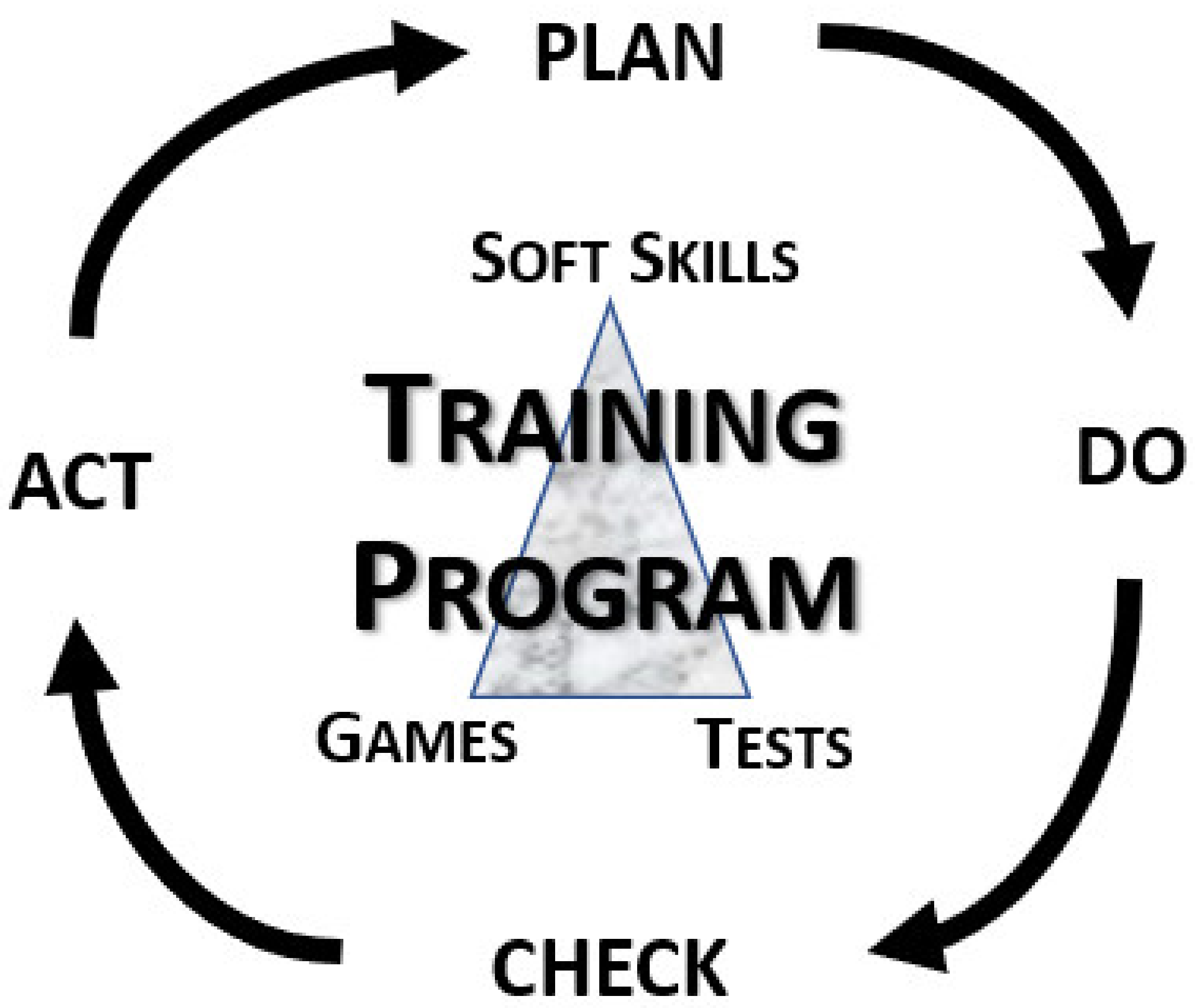
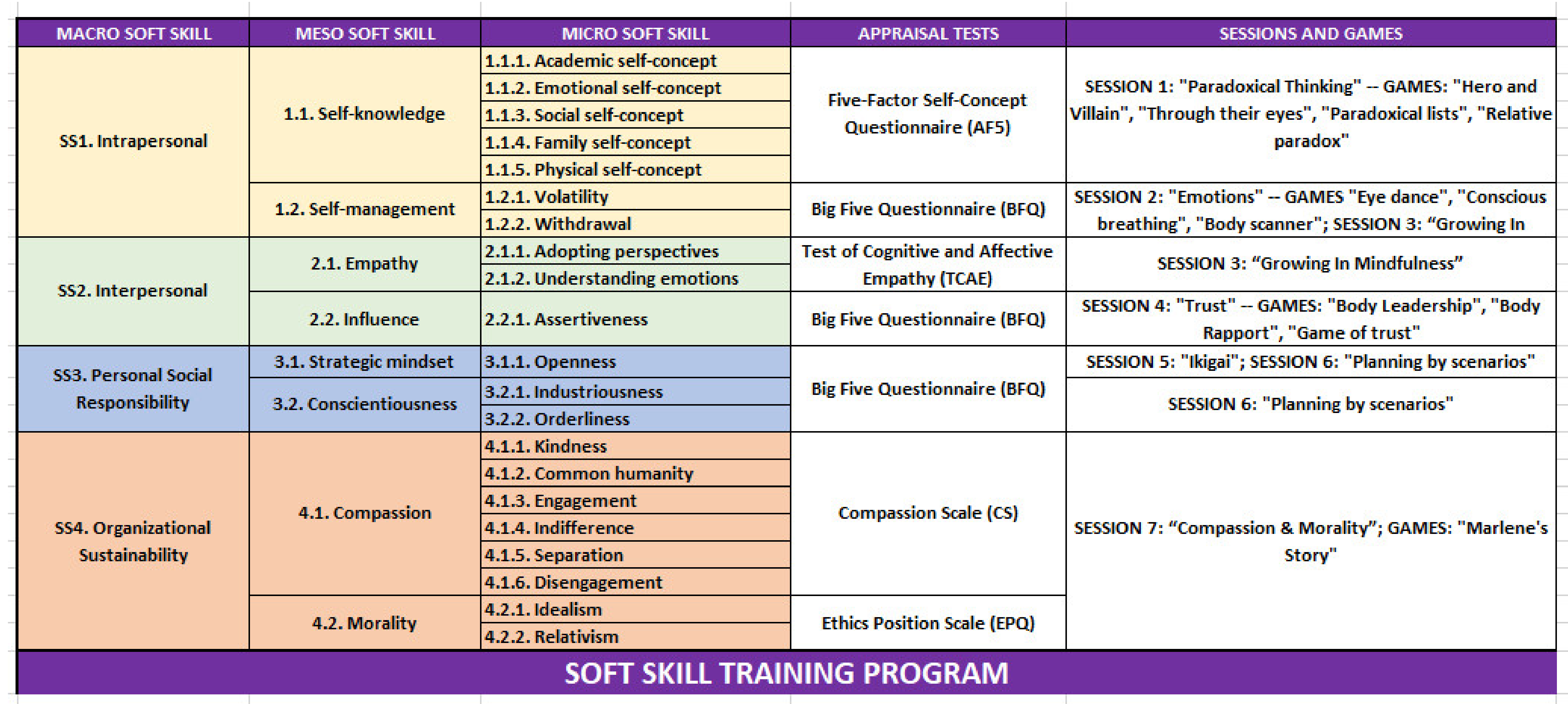
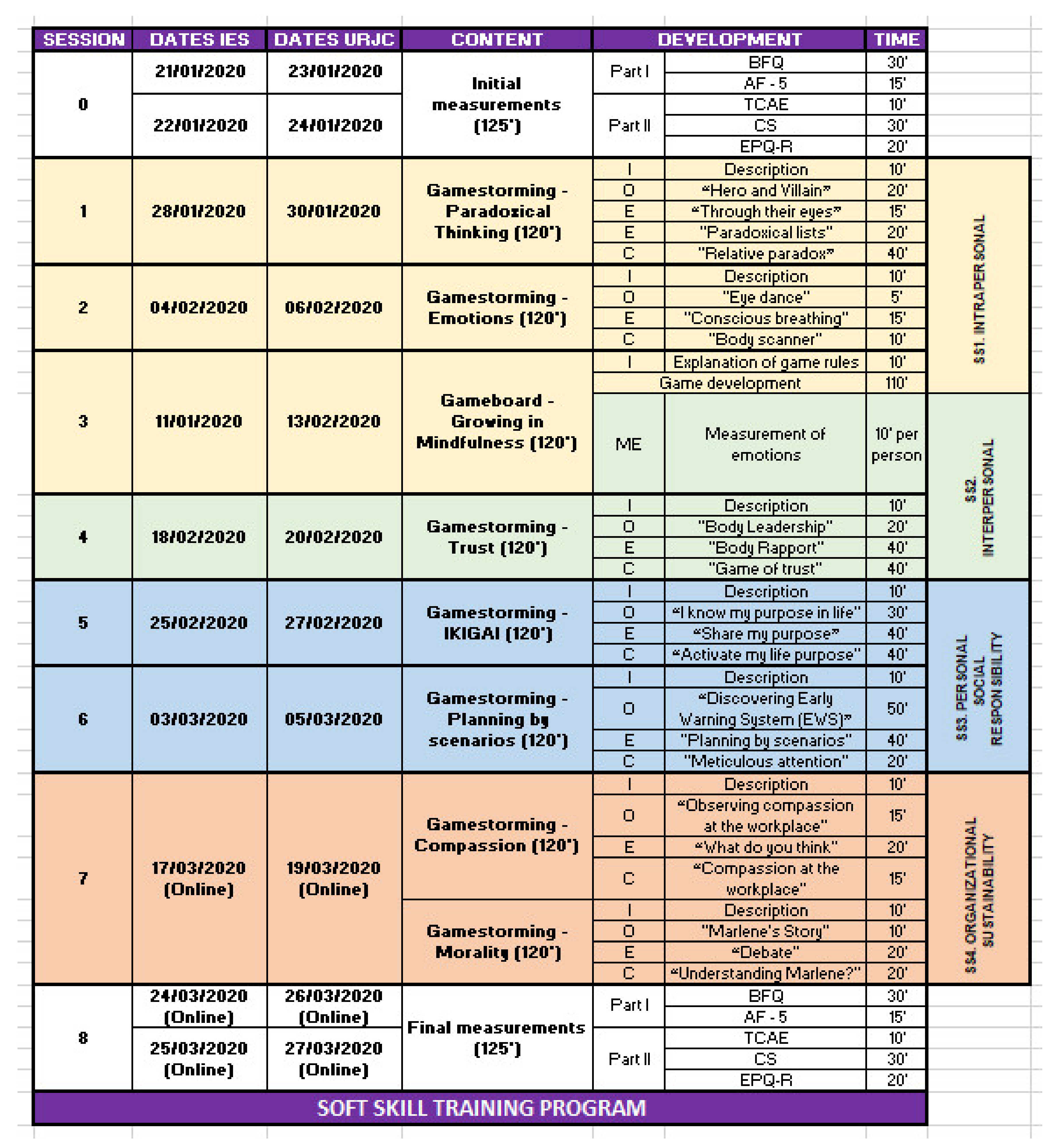
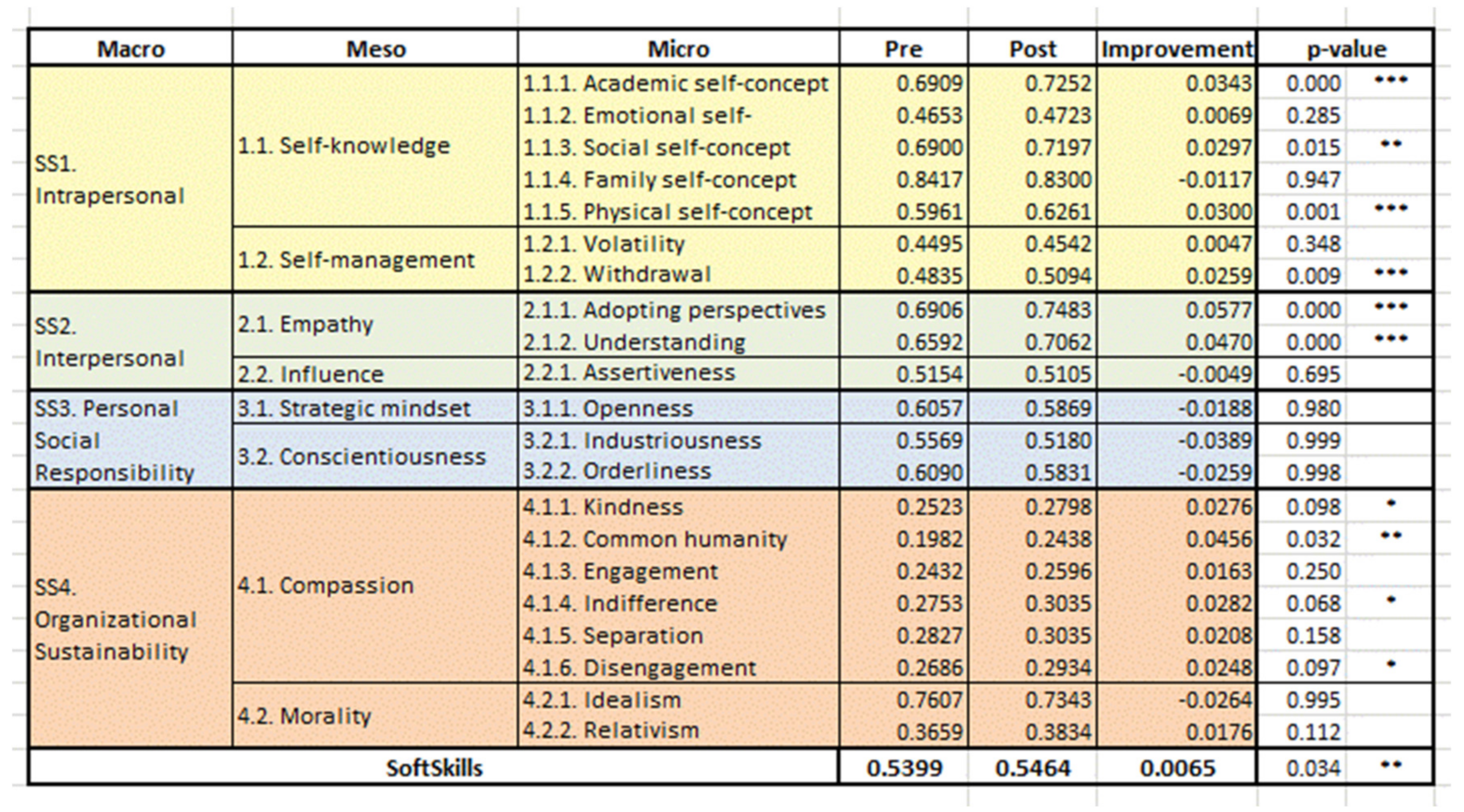
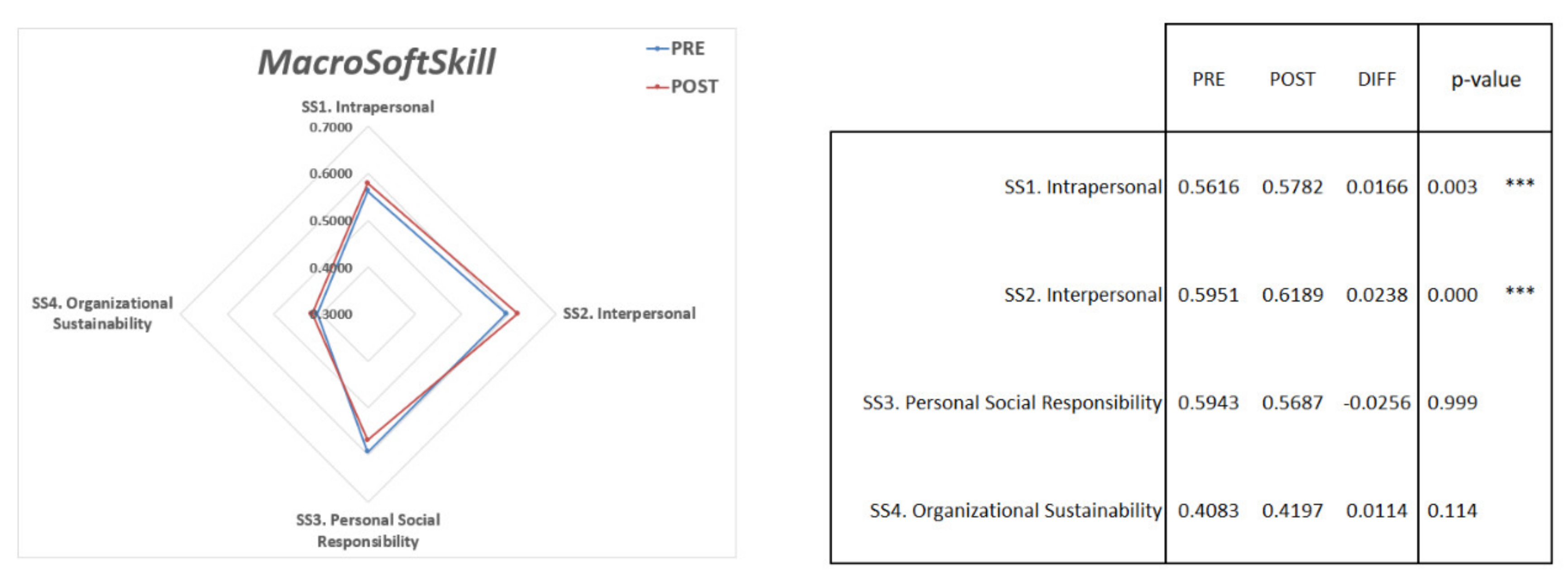

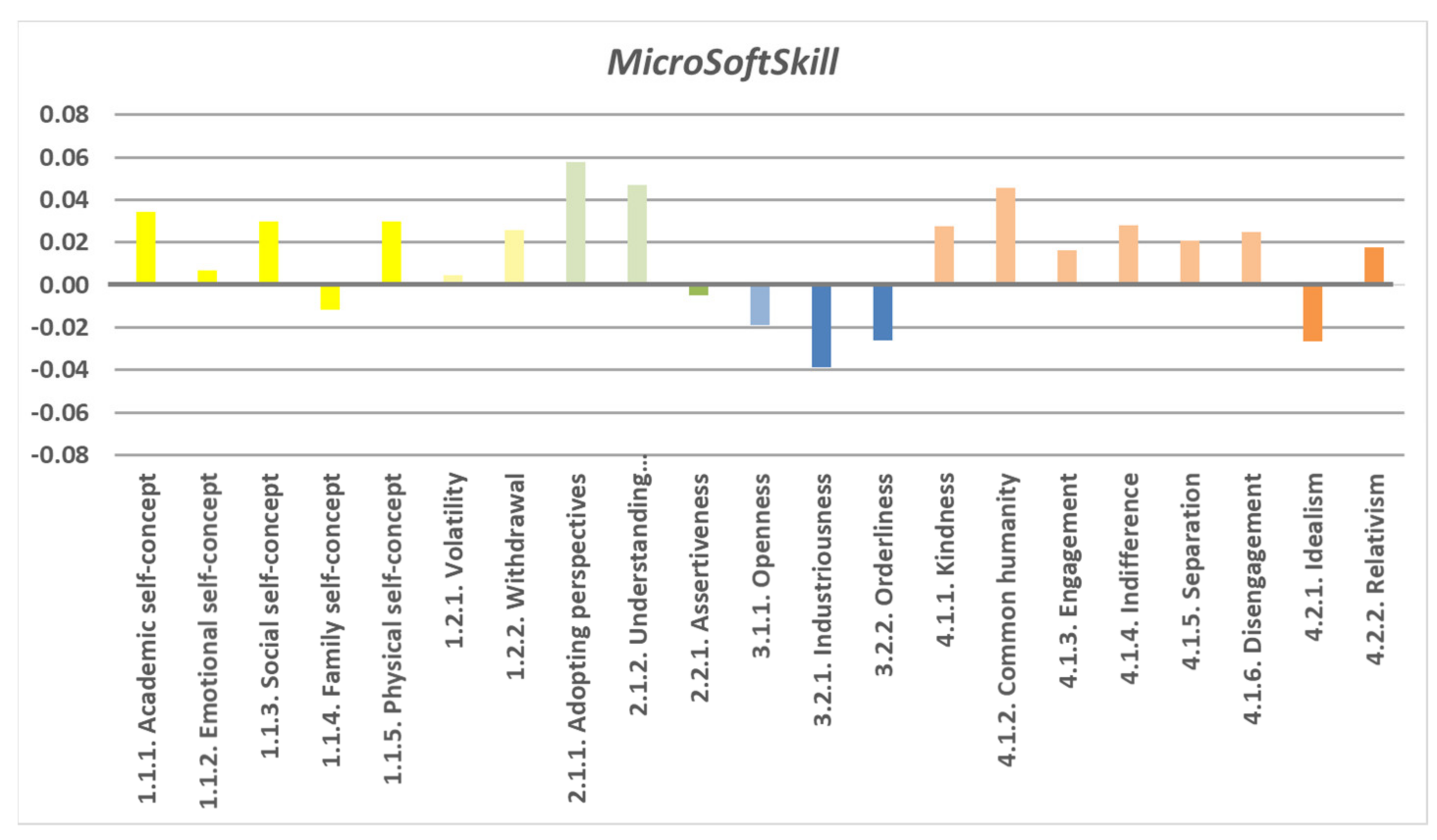
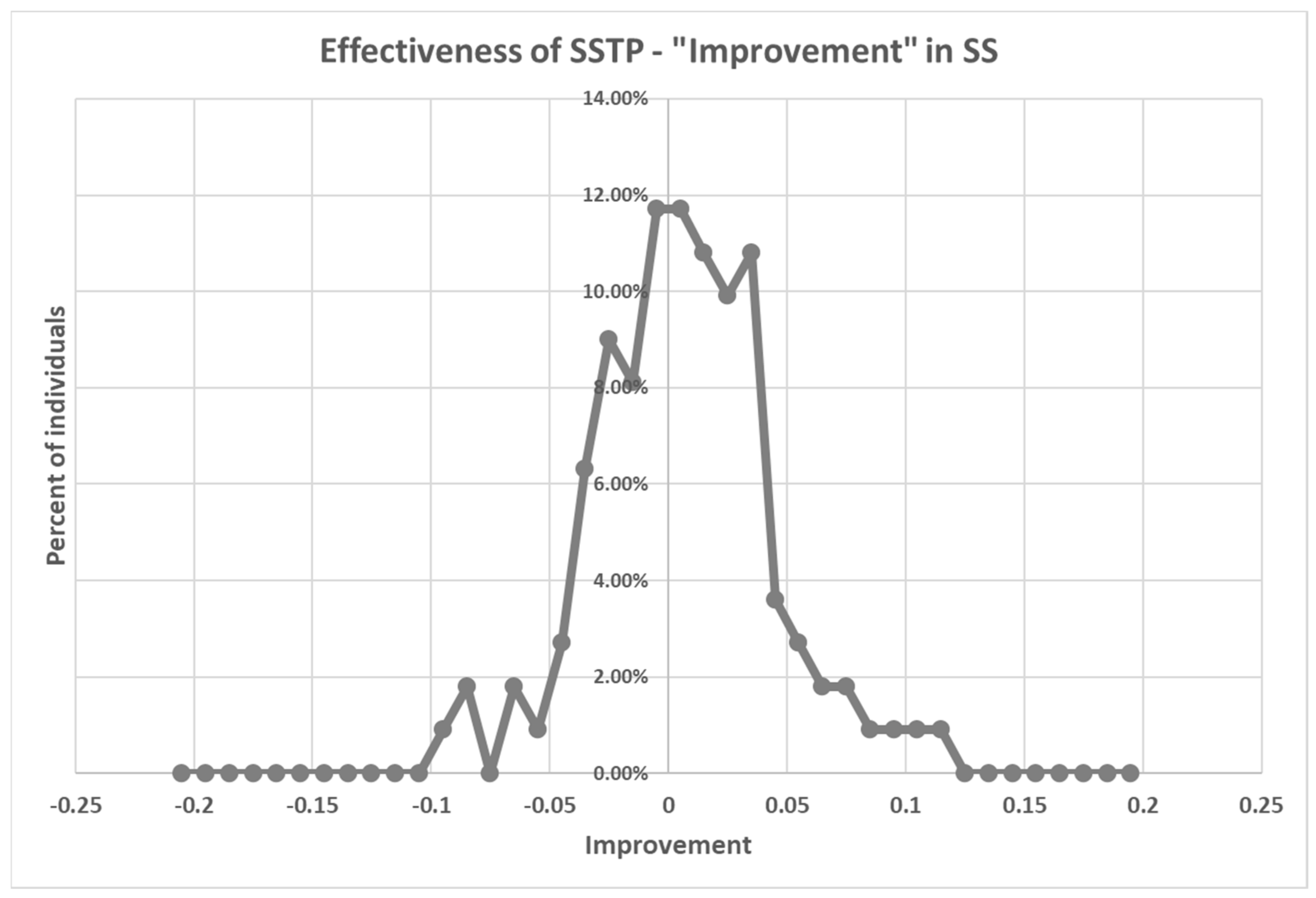
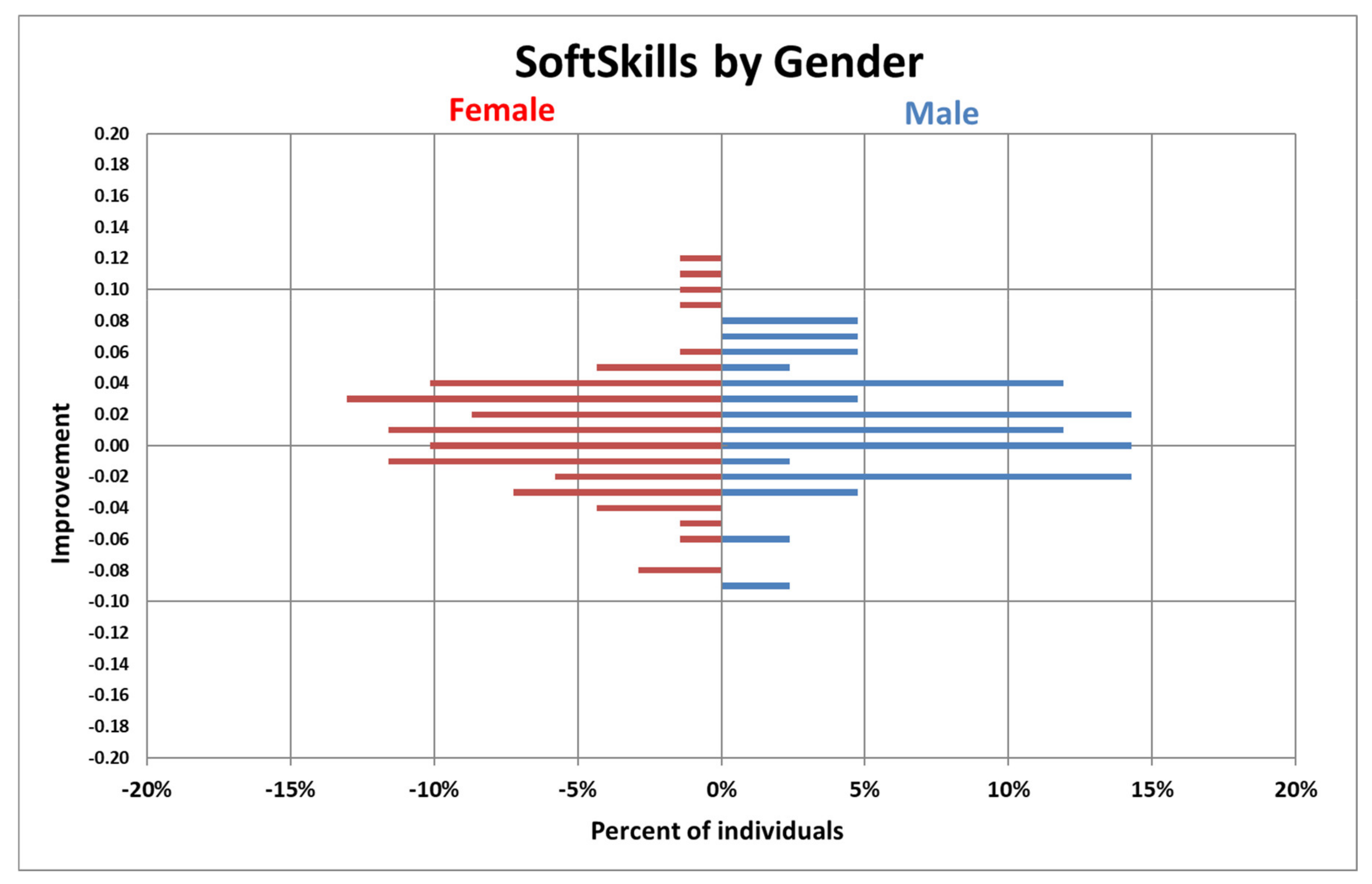

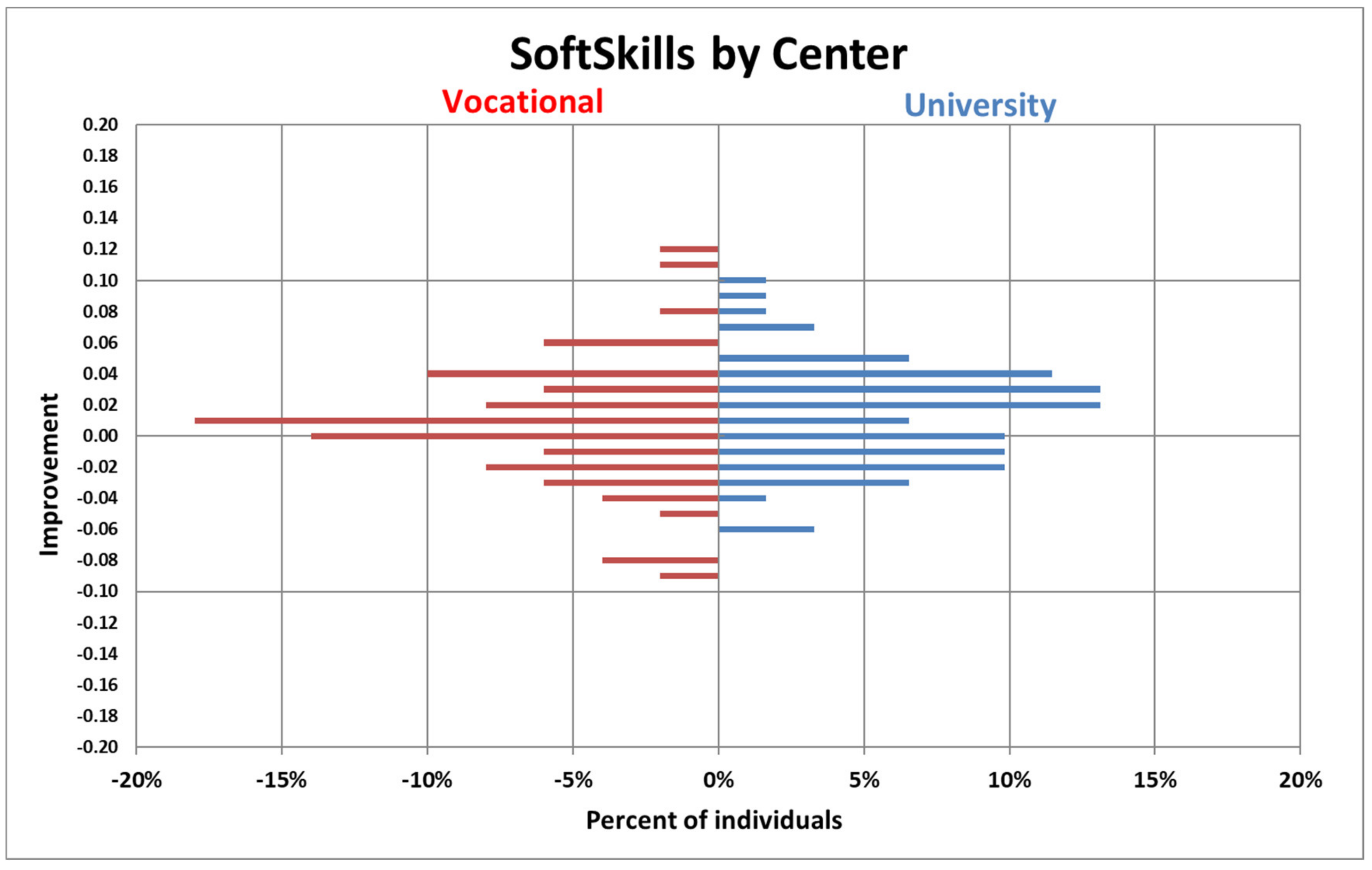


Publisher’s Note: MDPI stays neutral with regard to jurisdictional claims in published maps and institutional affiliations. |
© 2021 by the authors. Licensee MDPI, Basel, Switzerland. This article is an open access article distributed under the terms and conditions of the Creative Commons Attribution (CC BY) license (https://creativecommons.org/licenses/by/4.0/).
Share and Cite
Sutil-Martín, D.L.; Otamendi, F.J. Soft Skills Training Program Based on Serious Games. Sustainability 2021, 13, 8582. https://doi.org/10.3390/su13158582
Sutil-Martín DL, Otamendi FJ. Soft Skills Training Program Based on Serious Games. Sustainability. 2021; 13(15):8582. https://doi.org/10.3390/su13158582
Chicago/Turabian StyleSutil-Martín, Dolores Lucía, and F. Javier Otamendi. 2021. "Soft Skills Training Program Based on Serious Games" Sustainability 13, no. 15: 8582. https://doi.org/10.3390/su13158582
APA StyleSutil-Martín, D. L., & Otamendi, F. J. (2021). Soft Skills Training Program Based on Serious Games. Sustainability, 13(15), 8582. https://doi.org/10.3390/su13158582




